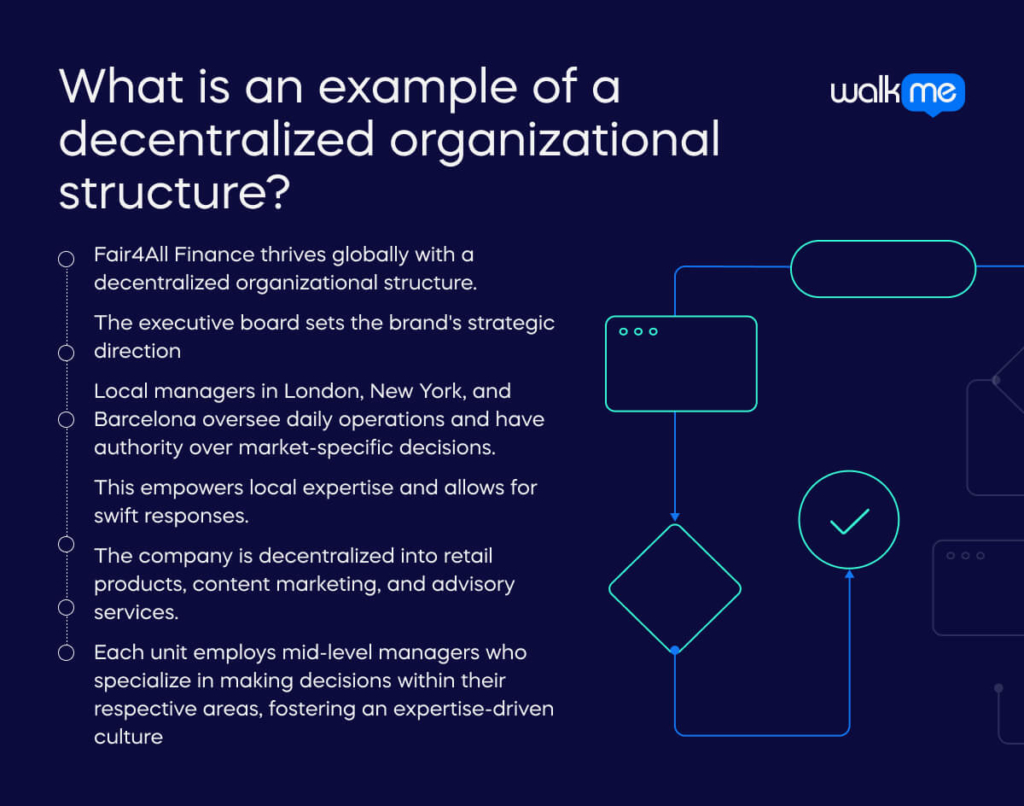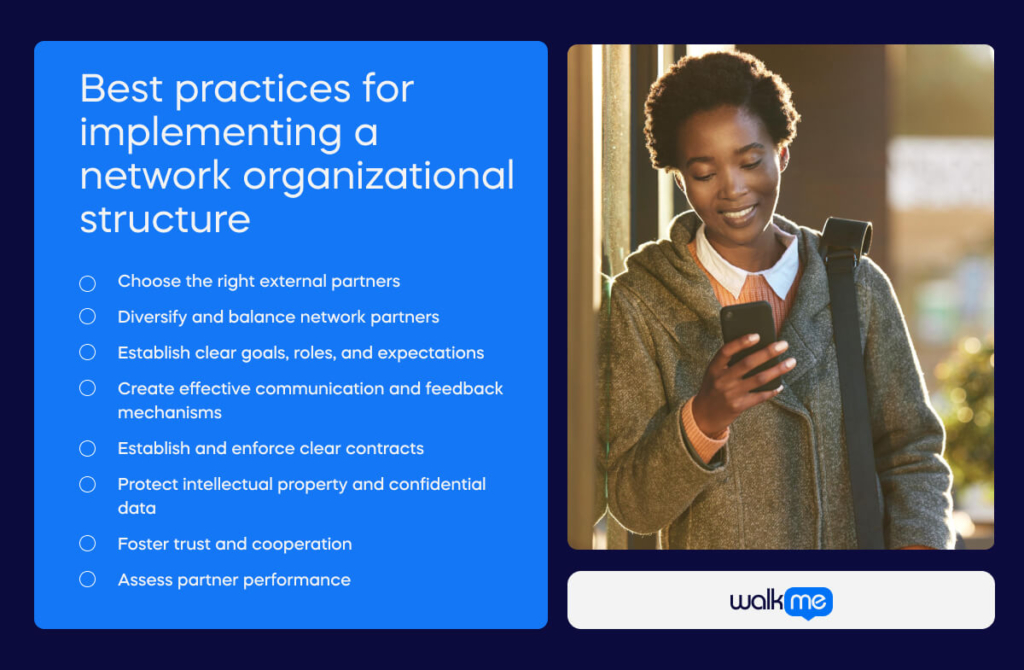Hierarchical structures have long been the traditional approach to organizational design. Yet, many startups and global corporations now embrace flatter, more egalitarian models that can improve efficiency and agility.
A decentralized organizational structure reduces management burdens while empowering employees to make decisions. This shift encourages accountability and independence across all levels of the business. To succeed, however, organizations often rely on strong change management practices to guide teams through the transition and embed new ways of working.
Distributing decision-making power can enhance responsiveness, foster innovation, and support business transformation in fast-paced environments.
In this article, we’ll define decentralized organizational structures and examine their key characteristics. We’ll also compare centralized and decentralized approaches, share an example, and provide practical tips for implementation.
What are decentralized organizational structures?
In a decentralized organizational structure, all employees can decide. It is not something only reserved for the top.
The top level of the organization makes all decisions in a hierarchical structure. The C-suite level handles decision-making. This ensures consistency and control through a few people. Yet, this can cause delays in decision-making, decreased flexibility, and limited innovation.
In contrast, decentralized organizational structures delegate decision-making power to frontline teams. Faster decisions, adaptability, and agility- all lead to happier customers. But decentralization does not mean chaos. A decentralized structure remains organized. But it has fewer bureaucratic layers and a flatter hierarchy.
What are the key characteristics of decentralized organizational structures?

Here are the main characteristics of decentralized organizational structures:
Self-managing teams
Decentralized organizational structures revolve around self-managing cross-functional teams that drive projects. These teams have the freedom to decide and oversee their tasks. This cultivates a sense of ownership and accountability.
Flatter structure
Fewer management layers define decentralized firms. This means less middle management. It encourages self-management and cuts bureaucratic delays.
Empowered decision-making
Inclusive decision-making is key. Diverse ideas can flow. Employees with more autonomy can react and make changes without waiting for approval.
Autonomy and agility
Decentralized structures empower teams. They respond to client needs and market shifts. This autonomy fuels ownership, accountability, innovation, and employee engagement. Creative ideas have room to flourish, leading to faster implementation of innovative solutions.
Distributed decision-making
The distribution of decision-making is a defining trait of decentralized organizations. The organization delegates decision-making authority to team members at lower levels. You can do this instead of centralizing it in the C-suite.
This allows employees in specific departments or teams to decide. This reduces the need for constant approval from higher levels. Thus, agile leaders can concentrate on strategic planning. This is instead of getting overwhelmed by operational choices.
Data-driven decisions
In decentralized organizations, data and analytics play a vital role in decision-making. Decentralized teams gain logical insights from centralized data systems. This makes confident decision-making possible at all levels without consulting upper management. Using a data-driven approach guarantees well-informed and timely decision-making.
What is the difference between a centralized and decentralized organizational structure?
Companies often choose between a centralized and decentralized organizational structure. You can do this to establish management protocols and ensure clear communication.
Remember to grasp the distinctions between the two before choosing. You need to consider factors like team size, range of products, and global market reach.
Here are the vital differences between the two:
| Centralized | Decentralized | |
| Typical size of organization | Suitable for smaller organizations. | Best for larger firms |
| Communication | The top executives make all the decisions that others have to follow. | There is more collaboration between employees, which means more open and transparent communication. |
| Decision-making | Slower decisions (one management body) | Faster decisions (leaders at all levels) |
| Career advancement | Fewer career options. | More standardized career options. |
| Creativity | All employees need to follow standardized procedures. | Allows experimentation and innovation |
| Cost | Less expensive as fewer managers and the same teams for specific services. | More expensive as there are more managers at every level with their own service functions. |
What is an example of a decentralized organizational structure?

Fair4All Finance leverages a decentralized organizational structure to thrive in its global operations.
The executive board sets the brand’s strategic direction. The local operation managers in London, New York, and Barcelona manage day-to-day functions and have the authority to make market-specific decisions.
This empowers local expertise and allows for swift responses. The company is further decentralized by dividing it into retail products, content marketing, and advisory services.
Each unit has mid-level managers who make specialized decisions within their area, promoting a culture of expertise.
Striking a balance is key. While local managers and units have decision-making power, the executive board maintains consistency through company-wide standards. This helps ensure a unified customer experience across all locations.
This decentralized approach and clear standards empower Fair4All Finance to be agile and successful in a global marketplace.
Best practice for implementing a decentralized organizational structure

Consider these tips before implementing a decentralized organizational structure:
Assess suitability
You need to consider many factors to decide if a decentralized structure works for you. Analyze the scale of your organization. Larger companies might experience more benefits from decentralization.
This is because of the complexity and diversity of their operations. Consider the level of autonomy your employees need to be effective. Some roles may enjoy greater independence.
Support independent decision-making
All employees must have the skills and knowledge. This makes decentralized decision-making effective. Focus on investment in training programs. These include leadership development, critical thinking, effective communication, collaboration, and problem-solving.
This training is essential because it enables people to make informed choices. It also promotes a culture of trust and responsibility.
Establish clear guidelines
Clear guidelines and a shared vision help decentralized teams stay aligned. Leaders need to communicate core values and establish reliable frameworks for decision-making. These frameworks ensure consistency and coherence throughout the organization.
One also cannot overstate the effectiveness of mid-level and lower-level managers. This makes quality recruitment and continuous learning essential.
Ensure consistent decision-making
All departments in a successful decentralized organization must have consistent decision-making processes. Create a decision-making framework for the entire company. This framework must provide clear steps and procedures. Effective dissemination requires training all employees in this framework.
Invest in leadership development
Identify and cultivate talent within the organization to maintain a decentralized structure. Identify and appreciate managers and team members who achieve results through informed decision-making. To further enhance their capabilities, invest in developing their leadership skills.
This investment boosts both career growth and leadership capacity for the organization. Encouraging continuous learning helps maintain a high standard of decision-making across all levels.
Maintain alignment with centralized strategy
Once you implement a decentralized structure, you must create a centralized strategy for long-term objectives. Senior leaders must give this plan a clear strategic direction and ensure coordination toward shared goals.
The centralized strategy integrates decentralized efforts into a unified approach. Upper management’s role is crucial in guiding and aligning the organization. This ensures that decentralized decisions support the business strategy.
Improve communication and knowledge-sharing
Effective communication and knowledge sharing are essential to prevent duplication and keep everyone informed. Create a network of clear and consistent communication channels throughout the organization. Introduce platforms for employees to access critical project information. You can also use these platforms for company updates and other relevant information.
Encourage employees to feel comfortable sharing ideas and feedback. This fosters a collaborative and transparent culture. It also breaks down silos and promotes innovation.
Focus on results
In a decentralized organization, senior management should focus on results rather than micromanaging decisions. Analyzing outcomes and employee performance metrics can help assess the effectiveness of local managers.
You give local managers the freedom to decide and adapt. This creates a dynamic and responsive work environment. Keep only effective and reliable decision-makers to uphold leadership quality in the organization.
Use tried-and-trusted solutions
Decentralized organizations can enhance innovation by leveraging trusted solutions from peers. Build a central repository where you can document important processes. This repository can also hold successful processes with various teams.
Historical project data enables project managers to make more accurate forecasts. Teams can leverage this knowledge base to learn from the past.
Centralize tech and tools
Consolidating technology, tools, and data facilitates cross-team communication and information exchange. Create systems that promote effortless access to important data and resources. This empowers teams to make informed decisions. Create measurable performance metrics to check decision effectiveness throughout the organization.
Make sure that your employees understand the assessment criteria. Leaders should also give feedback on areas for improvement and development. This method promotes accountability and a culture of constant improvement and excellence.
Key takeaways for decentralized organizational structures
A decentralized organizational structure grants department heads and project managers decision-making power. This frees up top management to concentrate on strategic business priorities.
This approach differs from a centralized structure. Top executives still make the major decisions. However, decentralized companies divide more decision-making power among middle management. Middle managers can run daily operations. They can do this with no approval from directors and C-suite executives.
Implementing a decentralized structure requires a commitment from the entire organization. Understanding the implications and making necessary adjustments is crucial. The new approach requires comprehensive employee training. It also needs clear communication to ensure alignment among everyone.
Before adopting a decentralized model, consider the implications of this structure. Consider the pros and cons. Verify that your organization can embrace the needed adjustments. The collective effort is crucial for successful decentralization.


